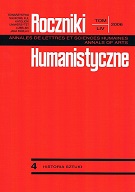Koleje życia Antoniego Herliczki, malarza polskiego XVIII wieku
Antoni Herliczka’s Vicissitudes of Life the Polish Painter of the Eighteenth Century
Author(s): Jan NiecieckiSubject(s): Cultural history
Published by: Towarzystwo Naukowe KUL & Katolicki Uniwersytet Lubelski Jana Pawła II
Keywords: altar; commission; painting; plaster; primer; reconstruction; room; hall; vaults
Summary/Abstract: The painter Antonius Johannes Herliczka, actually: Herdlitzka (in the archives he is also called Herlitzka, Cherliczka, Erliczka, Jerliczka, Irliczka, Herliczko, Erliczko, Herlicki, and Irlicki), was born ca. 1720 and died after 1792. He came from the Habsburg monarchy (from the Bohemia) and bore the seven-club crown coat-of-arms (usurpation?). In the years of 1749-1751 (1753?) he lived in Warszawa. He was the court painter of Jan Klemens Branicki (1753-1771), then Izabella Branicka née Poniatowska, a widow and life tenant. From 1753 on he lived in Białystok, and from 1754 on in the newly built house at Nowe Miasto street, granted to him on 8th July 1771. In 1779 he took out a lease on aldermanship of Hac´ki near Bran´ sk, got married on 17th February 1754 in Białystok to Marianna Paszkowska (1740-1768), a daughter of a post office secretary. They had 7 (8) children. He was a member of the Archfraternity of the Holy Trinity at a Białystok church. Until 1749 he worked as a journeyman with Georg Wilhelm Josef Neunhertz. He himself made painting works, rarely helped by “painters.” In later years his oldest son, Józef Henryk (baptised on 25th January 1757 in Białystok), helped him. I. Branicka sent him in 1781 to Warszawa for a several-month training with Vincenzo Brenna. Herliczka pursued above all wall painting. He also painted easel paintings, especially frontons and portraits, and realised other assignments (e.g. he decorated carriages). He designed sculptures and stuccoes, but did not sign his works. Few frescoes have been preserved (mezzo fresco, and completed by al secco), and still fewer Herliczka’s easel paintings show him as a prominent and proficient artist in terms of technique. (…)
Journal: Roczniki Humanistyczne
- Issue Year: 54/2006
- Issue No: 04
- Page Range: 225-290
- Page Count: 66
- Language: Polish

